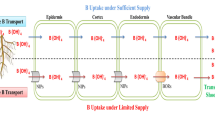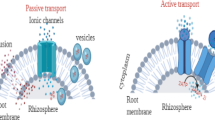Abstract
Heavy metal allocation in clonal organs, stems, leaves, and roots has not been systematically studied for rhizomatous perennial plants. Here, pot experiments have been designed to investigate lead (Pb) distribution in different organs of Phragmites australis (Cav.) Trin. ex Steud. Common reed subjected to 0–4500 mg Pb kg−1 under both flood and drought conditions. In either water treatment, Pb concentrations in offspring shoots were lower than in parent shoots; however, the opposite response was observed for biomass allocation for which parent shoots protected offspring shoots. Lower allocation of Pb to leaves rather than stems in offspring shoots could be a protective strategy of leaves under flood conditions. Lower Pb allocation to rhizomes is better for rhizome growth. This further provides energy for the growth of buds and offspring shoots, because the rhizome biomass and the number of buds and offspring shoots were not significantly inhibited by Pb levels of ≤ 3000 mg kg−1 in the flooded environment. These Pb allocation strategies could enhance the resistance capacity of reeds to Pb contamination by stabilizing population propagation and productivity, especially at Pb levels of ≤ 3000 mg kg−1 under flood conditions.






Similar content being viewed by others
References
Ahmed, A. & H. Tajmir-Riahi, 1993. Interaction of toxic metal ions Cd2+, Hg2+, and Pb2+ with light-harvesting proteins of chloroplast thylakoid membranes. An ftir spectroscopic study. Journal of Inorganic Biochemistry 50(4): 235–243.
Asch, F., M. Dingkuhn, A. Sow & A. Audebert, 2005. Drought-induced changes in rooting patterns and assimilate partitioning between root and shoot in upland rice. Field Crops Research 93(2–3): 223–236.
Bankó, L., M. Ördög & L. Erdei, 2002. The role of rhizome system in the distribution of cadmium load among ramets of Phragmites australis. Acta Biologica Szegediensis 46(3–4): 81–82.
Benson, E. J. & D. C. Hartnett, 2006. The role of seed and vegetative reproduction in plant recruitment and demography in tallgrass prairie. Plant Ecology 187(2): 163–178.
Bonanno, G., 2011. Trace element accumulation and distribution in the organs of Phragmites australis (Common reed) and biomonitoring applications. Ecotoxicology and Environmental Safety 74(4): 1057–1064.
Bonanno, G. & R. Lo Giudice, 2010. Heavy metal bioaccumulation by the organs of Phragmites australis (Common reed) and their potential use as contamination indicators. Ecological Indicator 10(3): 639–645.
Bragato, C., H. Brix & M. Malagoli, 2006. Accumulation of nutrients and heavy metals in Phragmites australis (cav.) trin. Ex steudel and Bolboschoenus maritimus (L.) palla in a constructed wetland of the venice lagoon watershed. Environmental Pollution 144(3): 967–975.
de Silva, N. D. G., E. Cholewa & P. Ryser, 2012. Effects of combined drought and heavy metal stresses on xylem structure and hydraulic conductivity in Red maple (Acer rubrum L.). Journal of Experimental Botany 63(16): 5957–5966.
Du Laing, G., G. Van Ryckegem, F. M. G. Tack & M. G. Verloo, 2006. Metal accumulation in intertidal litter through decomposing leaf blades, sheaths and stems of Phragmites australis. Chemosphere 63(11): 1815–1823.
Dunbabin, J. S. & K. H. Bowmer, 1992. Potential use of constructed wetlands for treatment of industrial wastewaters containing metals. Science of the Total Environment 111(2): 151–168.
Ensley, B. D., 2000. Rationale use for phytoremediation. In Raskin, I. & B. D. Ensley (eds), Phytoremediation of Toxic Metals: Using Plants to Clean Up the Environment. Wiley, New York: 3–11.
Fernandes, P. M., J. A. Vega, E. Jiménez & E. Rigolot, 2008. Fire resistance of European pines. Forest Ecology and Management 256: 246–255.
Fürtig, K., D. Pavelic, C. Brunold & R. Brändle, 1999. Copper-and iron-induced injuries in roots and rhizomes of reed (Phragmites australis). Limnologica—Ecology Manage Inland Waters 29(1): 60–63.
Ghosh, M. & S. A. Singh, 2005. Review on phytoremediation of heavy metals and utilization of it’s by products. Asian Jounal on Energy and Environment 6(4): 214–231.
Godzik, B., 1993. Heavy metals content in plants from zinc dumps and reference areas. Polish Botanical Studies 5: 113–132.
Guo, H. Y., J. G. Zhu, H. Zhou, Y. Y. Sun, Y. Yin, D. P. Pei, R. Ji, J. C. Wu & X. R. Wang, 2011. Elevated CO2 levels affects the concentrations of cooper and cadmium in crops grown in soil contaminated with heavy metals under fully open-air field conditions. Environmental Science and Technology 45(16): 6997–7003.
Harper, J. L., 1977. Population Biology of Plants. Academic Press, London: 892.
Hartnett, D. C., M. P. Setshogo & H. J. Dalgleish, 2006. Bud banks of perennial savanna grasses in Botswana. African Journal of Ecology 44: 256–263.
Henry, C. P. & C. Amoros, 1996. Are the banks a source of recolonization after disturbance: an experiment on aquatic vegetation in a former channel of the rhône river. Hydrobiologia 330(2): 151–162.
Hu, R., K. Sun, X. Su, Y. X. Pan, Y. F. Zhang & X. P. Wang, 2012. Physiological responses and tolerance mechanisms to Pb in two xerophils: Salsola passerine bunge and Chenopodium album (L.). Journal of Hazardous Materials 205–206: 131–138.
Islam, E., D. Liu, T. Q. Li, X. E. Yang, X. F. Jin, Q. Mahmood, S. K. Tian & J. Y. Li, 2008. Effect of Pb toxicity on leaf growth, physiology and ultrastructure in the two ecotypes of Elsholtzia argyi. Journal of Hazardous Materials 154(1–3): 914–926.
Judith, S. W., G. Terry & W. Peddrick, 2004. Interactions of metals affect their distribution in tissues of Phragmites australis. Environmental Pollution 131(3): 409–415.
Keller, B. E., K. Lajtha & S. Cristofor, 1998. Trace metal concentrations in the sediments and plants of the Danube Delta, Romania. Wetlands 18(1): 42–50.
Klimešová, J. & L. Klimeš, 2008. Clonal growth diversity and bud banks of plants in the czech flora: an evaluation using the clo-pla3 database. Preslia 80(3): 255–275.
Klimov, S., 1985. Interaction of stress factors: increase of drought effect by the presence of Al3+ in the medium. Fiziologi Rasteni 32: 532–538.
Li, Z. L., J. X. Lin, T. Y. Zhang, N. Zhang, C. S. Mu & J. F. Wang, 2014. Effects of summer nocturnal warming on biomass production of Leymus chinensis in the Songnen Grassland of China: from bud bank and photosynthetic compensation. Journal of Agronomy and Crop Science 200(1): 66–76.
Liu, B., Z. M. Liu, L. X. Wang & Z. N. Wang, 2014. Responses of rhizomatous grass Phragmites communis to wind erosion: effects on biomass allocation. Plant and Soil 380(1–2): 389–398.
Lu, R. K., 2000. Methods of Agricultural and Chemical Analysis of Soils. Agricultural Science and Technology Press of China, Beijing: 12–163.
Major, J. E., A. Mosseler, J. W. Malcolm & S. Heartz, 2017. Salinity tolerance of three Salix species: survival, biomass yield and allocation, and biochemical efficiencies. Biomass and Bioenergy 105: 10–22.
Małkowski, E., A. Kita, W. Galas, W. Karcz & J. M. Kuperbery, 2002. Lead distribution in corn seedlings (Zea mays L.) and its effect on growth and the concentrations of potassium and calcium. Plant Growth Regulation 37(1): 69–76.
Mitchell, L. & A. Karathanasis, 1995. Treatment of metal-chloride-enriched waste water by simulated constructed wetlands. Environmental Geochemistry Health 17(3): 119–126.
Mitsch, W. J. & J. G. Gosselink, 2000. Wetlands. Wiley, New York.
Mony, C., S. Puijalon & G. Bornette, 2011. Resprouting response of aquatic clonal plants to cutting may explain their resistance to spate flooding. Flia Geobotanica 46: 155–164.
Nishihiro, J., S. Araki, N. Fujiwara & I. Washitani, 2004. Germination characteristics of lakeshore plants under an artificially stabilized water regime. Aquatic Botany 79(4): 333–343.
Papazogloua, E. G., G. A. Karantouniasa, S. N. Vemmosb & D. L. Bouranis, 2005. Photosynthesis and growth responses of giant reed (Arundo donax L.) to the heavy metals Cd and Ni. Environment International 31: 243–249.
Peverly, J. H., J. M. Surface & T. Wang, 1995. Growth and trace metal absorption by Phragmites australis in wetlands constructed for landfill leachate treatment. Ecological Engineering 5(1): 21–35.
Pezeshki, S. R., R. D. DeLaune & J. F. Meeder, 1997. Carbon assimilation and biomass partitioning in Avicennia germinans and Rhizophora mangle seedlings in response to soil redox conditions. Environmental and Experiment Botany 37(2–3): 161–171.
Pietrini, F., M. A. Iannelli, S. Pasqualini & A. Massacci, 2003. Interaction of cadmium with glutathione and photosynthesis in developing leaves and chloroplasts of Phragmites australis (cav.) trin. Ex steudel. Plant Physiology 133(2): 829–837.
Ryser, P. & P. Emerson, 2007. Growth, root and leaf structure, and biomass allocation in Leucanthemum vulgare lam. (Asteraceae) as influenced by heavy-metal-containing slag. Plant and Soil 301(1–2): 315–324.
Salt, D. E., M. Blaylock, N. P. B. A. Kumar, V. Dushenkov, D. Ensley, I. Chet & I. Raskin, 1995. Phytoremediation: a novel strategy for the removal of toxic metals from the environment using plants. Nature Biotechnology 13: 468–474.
Sharma, P. & R. S. Dubey, 2005. Lead toxicity in plants. Brazilian Journal of Plant Physiology 17(1): 35–52.
Taiz, L. & E. Zeiger, 2010. The response and adaptation to abiotic stress. In Green, L. & K. Emerson (eds), Plant Physiology, 5th ed. Sinauer Associates, Inc., Massachusetts: 605–616.
Wang, P., S. Zhang, C. Wang & J. Lu, 2012. Effects of Pb on the oxidative stress and antioxidant response in a Pb bioaccumulator plant Vallisneria natans. Ecotoxicology and Environmental Safety 78: 28–34.
Yang, Y. & H. A. Lang, 1997. Study of population regulation of phragmites communis as a clonal plant in different ecological conditions. Acta Pratacult Sinica 7(2): 1–9.
Ye, Z., A. Baker, M. Wong & A. J. Willis, 1997. Zinc, lead and cadmium tolerance, uptake and accumulation by the Common reed, Phragmites australis (cav.) trin. Ex steudel. Annal of Botany 80(3): 363–370.
Ye, Z. H., M. H. Wong, A. J. M. Baker & A. J. Willis, 1998. Comparison of biomass and metal uptake between two populations of Phragmites australis grown in flooded and dry conditions. Annal of Botany 82(1): 83–87.
Ye, Z., A. Baker, M. Wong & A. J. Willis, 2003. Copper tolerance, uptake and accumulation by Phragmites australis. Chemosphere 50(6): 795–800.
Yilmaz, D. D. & A. Aksoy, 2004. Accumulation of heavy metals in Typha angustifolia (L.) and Potamogeton pectinatus (L.) living in sultan marsh (kayseri, turkey). Chemosphere 56(7): 685–696.
Zhang, J. T., C. S. Mu, D. L. Wang, J. Wang & J. Chen, 2009. Shoot population recruitment from a bud bank, over two seasons of undisturbed growth of Leymus chinensis. Canadian Journal of Botany 87: 1242–1249.
Acknowledgements
The authors gratefully acknowledge funding support from the Chinese Postdoctoral Science Foundation Funded Project (2017M621670), the National Key Basic Research Program of China (2015CB150801), the Open Fund of Jiangsu Provincial Key Laboratory of Palygorskite Science and Applied Technology (HPK201604 and HPK201705), the Independent Innovation Fund of Agricultural Science and Technology, Jiangsu Province (CX(16)1051), and the Open Project Program of the Key Laboratory of Vegetation Ecology of Ministry of Education, Northeast Normal University (130028712).
Author information
Authors and Affiliations
Corresponding authors
Additional information
Handling editor: Chris Joyce
Rights and permissions
About this article
Cite this article
Zhang, N., Chen, J., Li, Z. et al. Strategies for lead distribution in organs of Phragmites australis (Cav.) Trin. ex Steud. (Common reed) subjected to Pb pollution in flood and drought environments. Hydrobiologia 819, 53–66 (2018). https://doi.org/10.1007/s10750-018-3629-5
Received:
Revised:
Accepted:
Published:
Issue Date:
DOI: https://doi.org/10.1007/s10750-018-3629-5




